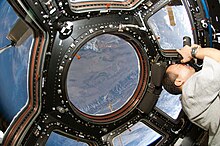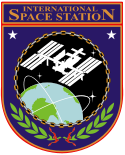Cupola
| Cupola | |
 | |
| Status | Aktiv |
|---|---|
| Rymdstation | ISS |
| I omloppsbana | 14 år, 7 månader och 11 dagar (19 september 2024) |
| Uppskjutning | |
| Uppskjutning | 8 februari 2010, 09:14 UTC[1] |
| Uppskjutningsplats | Kennedy Space Center LC-39A |
| Raket | STS-130 Endeavour |
| Uppskjutningsvikt | 1 805 kg[2] |
| Dockning | 12 februari 2010, 06:20 UTC |
| Omplacering | 15 februari 2010 |
| Mått | |
| Vikt | 1 880 kg |
| Diameter | 2,95 m |
| Höjd | 1,5 m |
| Dockningsportar | |
| Antal portar | 1 st |
| Porttyp | Common Berthing Mechanism |
| Zenit | Tranquility |
| Övrigt | |
| Fönster | 7 st |
 | |
Cupola är en observatoriemodul på internationella rymdstationen, ISS. Cupola är byggd av ESA.
Cupola har 7 fönster, det största har en diameter på 80 cm och är det största fönster människan placerat i rymden.
Dimensioner och vikt
- Höjd: 1,5 m
- Diameter: 2,95 m
- Vikt vid uppskjutning: 1 805 kg
- Vikt efter dockning: 1 880 kg
Uppskjutning
Cupola sköts upp med rymdfärjan Endeavour under flygningen STS-130, den 8 februari 2010. Under uppskjutningen var modulen dockad till den främre dockningsporten på modulen Tranquility, som också sköts upp med STS-130.
Dockning
Efter att Tranquility modulen dockats med modulen Unity, så flyttades Cupola till nadir porten på Tranquility.
- Vy från Cupola
- Cupola och Tranquility i Endeavours lastrum
Källor
Fotnoter
- ^ Manned Astronautics - Figures & Facts, Harmony Arkiverad 17 juni 2016 hämtat från the Wayback Machine., läst 17 augusti 2016.
- ^ ”ESA:s sida om Cupola” (på engelska). ESA. http://www.esa.int/Our_Activities/Human_Spaceflight/International_Space_Station/Cupola. Läst 28 augusti 2018.
| |||||||||||||||||||||||||||||||||||||||||||||
Media som används på denna webbplats
Backdropped by the blackness of space, NASA astronaut w:Ron Garan, Expedition 28 flight engineer, is pictured in a window of the Cupola of the International Space Station.
Cupola – ESA/Thales Alenia Space Italy (TAS-I)
- The Cupola (named after the raised observation deck on a railroad caboose) is a small module designed for the observation of operations outside the ISS such as robotic activities, the approach of vehicles, and extravehicular activity (EVA). It was built in Europe by Thales Alenia Space Italy (TAS-I) under contract of the European Space Agency. It provides spectacular views of Earth and celestial objects. The Cupola has six side windows and a direct nadir viewing window, all of which are equipped with shutters to protect them from contamination and collisions with orbital debris or micrometeorites. The Cupola is designed to house the robotic workstation that controls the ISS’s remote manipulator arm. It can accommodate two crewmembers simultaneously and is berthed to the Earth facing side of Node-3 using a Common Berthing Mechanism (CBM).
Japan Aerospace Exploration Agency (JAXA) astronaut Soichi Noguchi, Expedition 22 flight engineer, uses a still camera at a window in the Cupola of the International Space Station while space shuttle Endeavour (STS-130) remains docked with the station.
This high- angle 800mm image of the Tranquility node in space shuttle Endeavour's cargo bay was photographed by an Expedition 22 crew member aboard the International Space Station. The two spacecraft were in the process of their rendezvous activities which included a back-flip by Endeavour. Tranquility will be installed as the third node for the orbital outpost.







